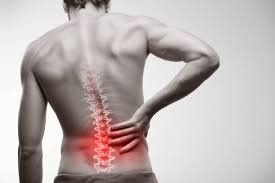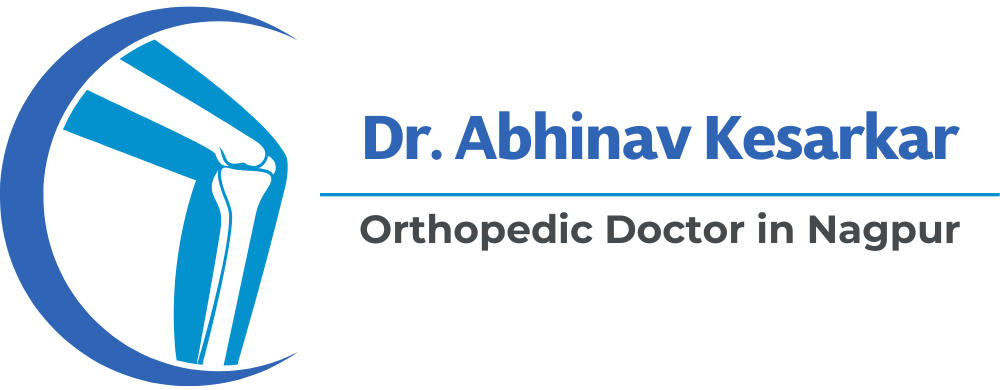Dr. Abhinav Kesarkar | Orthopedic Surgeon In Nagpur
Back pain treatment in Harda

Back pain treatment in Harda – Kesarkar Hospital
Back pain is one of the most common orthopedic concerns today, and it can affect individuals of every age group. Moreover, the intensity may vary from mild discomfort to severe, debilitating pain that limits movement and productivity. In many cases, poor posture, sedentary habits, or previous injuries gradually worsen the condition. However, when back pain becomes persistent or starts to interfere with daily activities, it’s important to seek timely medical attention.
That’s where Dr. Abhinav Kesarkar, a leading orthopedic specialist in Harda, steps in. With years of experience and advanced diagnostic expertise, he identifies the root cause of pain rather than merely addressing symptoms. Furthermore, he offers personalized and evidence-based back pain treatments that combine physiotherapy, medication, and lifestyle guidance. As a result, patients experience faster relief, improved flexibility, and long-term spinal health.
Types & Causes of Back Pain
Back pain is not a single disease but rather a symptom that can originate from several structures within the spine. These may include the vertebrae, intervertebral discs, nerves, ligaments, muscles, or facet joints. Moreover, lifestyle factors such as posture, repetitive strain, or injury often contribute to discomfort and stiffness.
a) Acute vs. Chronic Back Pain
Back pain can be acute, subacute, or chronic, depending on its duration and recurrence.
Acute back pain: Usually lasts from a few days up to six weeks. It often occurs due to sudden movements, muscle strain, lifting heavy loads, or minor injuries.
Subacute back pain: Persists for six to twelve weeks and may develop if the initial injury does not heal properly.
Chronic back pain: Continues beyond twelve weeks or keeps returning. Consequently, this form of pain requires a more detailed evaluation since it may stem from underlying structural or degenerative conditions.
In addition, chronic pain can affect daily activities, sleep quality, and overall mobility. Therefore, early diagnosis and professional management are essential for long-term relief.
b) Common Underlying Causes
When patients visit Dr. Abhinav Kesarkar for back pain, he thoroughly investigates the possible root causes. Below are some of the most frequent conditions he evaluates:
Muscle strain or ligament sprain: Occurs when the supporting muscles or ligaments of the spine are overstretched or torn.
Degenerative disc disease: As we age, spinal discs lose hydration and height, leading to instability and chronic discomfort.
Herniated or bulging disc: The disc material may protrude and press on nearby nerves, causing radiating pain, tingling, or leg weakness (commonly known as sciatica).
Facet joint arthritis: The small joints that connect the vertebrae can wear down, resulting in stiffness and pain during specific movements.
Spinal stenosis: A narrowing of the spinal canal or nerve exit openings that compresses spinal nerves and leads to pain or numbness.
Spondylolisthesis: A condition in which one vertebra slips forward over another, disrupting spinal alignment and stability.
Postural and mechanical pain: Poor posture, prolonged sitting, or weak core muscles frequently contribute to back strain.
Trauma or injury: Accidents, sports injuries, or sudden falls may cause acute or lasting pain.
Osteoporosis and vertebral fractures: In older adults, weakened bones can lead to compression fractures, producing sharp or persistent pain.
Because multiple structures can be involved, accurate diagnosis plays a crucial role before initiating treatment. Furthermore, identifying the exact source of pain allows for targeted therapy, which significantly improves recovery outcomes and prevents recurrence.
Diagnostic Workup: How Dr. Kesarkar Finds the Cause
To treat patients effectively, Dr. Abhinav Kesarkar follows a systematic and step-by-step diagnostic process. Each stage plays a vital role in identifying the root cause of pain and crafting a treatment plan that fits the patient’s exact condition. Moreover, this method ensures accuracy, minimizes guesswork, and promotes long-term recovery.
a) Medical History & Physical Examination
First, Dr. Kesarkar begins with a comprehensive medical history and physical examination. During this stage, he carefully evaluates multiple factors:
Detailed questioning: He asks about pain onset, character, location, and radiation, along with aggravating or relieving factors and any previous treatments.
Neurological examination: Furthermore, he conducts sensory tests, reflex checks, muscle strength assessments, and straight-leg raise and gait evaluations.
Posture and movement analysis: In addition, he observes alignment, flexibility, and muscle imbalances to detect underlying structural issues.
Through this initial assessment, Dr. Kesarkar gains valuable insights that guide further diagnostic testing and ensure a targeted approach.
b) Imaging & Diagnostic Tests
Next, depending on the findings from the physical exam, Dr. Kesarkar may recommend specific imaging or diagnostic studies to confirm the source of the problem.
X-ray (Spine): Used to identify fractures, alignment abnormalities, or degenerative changes.
MRI (Magnetic Resonance Imaging): Moreover, this test visualizes discs, nerves, ligaments, and soft tissues in greater detail.
CT Scan: If precise bony detail is required, a CT scan provides clear cross-sectional images.
Electrodiagnostic Studies (EMG & Nerve Conduction): Additionally, these tests assess nerve function, especially when nerve compression is suspected.
Bone Density Test (DEXA): Finally, in cases of suspected osteoporosis, this helps evaluate bone strength and density.
By combining clinical findings with advanced imaging, Dr. Kesarkar accurately determines whether the issue is mechanical or requires advanced intervention such as minimally invasive or surgical treatment. Consequently, patients receive a clear diagnosis and a customized path to recovery.
Treatment Approaches: Tailored to the Patient
Once the diagnosis is confirmed, treatment is carefully planned in phases, progressing from the least invasive options to more advanced procedures when necessary. Dr. Abhinav Kesarkar ensures that every patient clearly understands the benefits, risks, and expected recovery timeline before treatment begins.
A. Conservative / Non-Surgical Treatments (First Line for Most Patients)
These methods are safest and often highly effective, especially when applied early and consistently. Moreover, they aim to reduce pain, restore mobility, and prevent further joint or spine damage.
1. Medications & Pain Relief
To begin with, nonsteroidal anti-inflammatory drugs (NSAIDs) are commonly prescribed to manage inflammation and discomfort. In addition, muscle relaxants and analgesics (painkillers) help ease muscle tension and pain.
If pain persists, short-term use of stronger medications may be recommended under medical supervision. Therefore, patients can maintain comfort while continuing rehabilitation.
2. Physical Therapy & Exercise Programs
Physical therapy remains the cornerstone of long-term recovery. It focuses on improving strength, flexibility, and posture through guided exercises.
Core strengthening to stabilize muscles around the spine
Flexibility routines and stretching to maintain motion
Manual therapy, mobilization, and soft tissue techniques
Posture correction and ergonomics training
Guidance on safe movement, lifting, and bending
Furthermore, effective physiotherapy not only reduces pain but also prevents recurrence of injury by correcting movement patterns.
3. Heat / Cold Therapy, Massage & Modalities
Additionally, supportive therapies can help relieve discomfort and accelerate healing:
Heat packs or warm compresses to relax muscles
Cold therapy to minimize inflammation
Therapeutic massage, ultrasound, and TENS for pain modulation
Consequently, patients experience both immediate relief and long-term benefits when these are combined with exercise therapy.
4. Lifestyle & Ergonomic Changes
Lifestyle correction plays a vital role in sustainable recovery. For instance, maintaining correct posture while sitting or standing greatly reduces spinal strain. Moreover, the use of ergonomic chairs and a supportive mattress promotes alignment.
In addition, weight management, smoking cessation, and regular fitness routines contribute to improved musculoskeletal health and overall well-being.
5. Regenerative and Interventional Treatments
When standard therapies are insufficient, regenerative and interventional methods offer new possibilities.
PRP (Platelet-Rich Plasma) Therapy uses the patient’s own platelets to stimulate healing and decrease inflammation.
Nerve root blocks or epidural steroid injections are provided for pain linked to nerve compression.
Other minimally invasive injections may be suggested based on the location and nature of the problem.
Recent research indicates that PRP therapy may provide relief in disc-related back pain, although results vary among patients. Therefore, each intervention is chosen carefully according to the individual’s symptoms, anatomy, and severity of condition.
Rehabilitation & Post-Treatment Care
Treatment doesn’t end with surgery or an injection. In fact, recovery truly begins afterward. Proper rehabilitation and consistent follow-up care are essential for achieving lasting results. Moreover, structured post-operative therapy helps patients regain strength, flexibility, and confidence in movement.
Post-Operative Physiotherapy:
Gradual strengthening, flexibility, and gait training are introduced to rebuild muscle support. Furthermore, each session is carefully tailored to the patient’s progress, ensuring safe and steady improvement.
Activity Progression:
In addition, patients are guided to slowly resume daily tasks and sports activities under professional supervision. As a result, they regain normal function without putting excess stress on the healing joints.
Regular Monitoring:
Follow-up visits and, when necessary, repeat imaging allow the doctor to track recovery milestones. Consequently, any issues can be addressed early, preventing long-term complications.
Pain Management:
Medications are tapered gradually to control pain while minimizing side effects. Therefore, patients experience comfort and stability throughout the healing process.
Lifestyle Adjustments:
Maintaining good posture, avoiding heavy lifting, and performing regular core exercises further enhance recovery. Besides, these small lifestyle changes play a major role in preventing re-injury and improving joint health.
Ultimately, by actively participating in rehabilitation, patients achieve better outcomes, faster recovery, and a significantly reduced risk of recurrence.
Prognosis & Expected Outcomes
With expert care and proper adherence, many patients experience significant pain relief, improved joint function, and a better quality of life. In many conservative cases, patients respond well to non-surgical methods and successfully avoid the need for surgery.
For surgical candidates, minimally invasive techniques ensure faster recovery, cause less tissue damage, and provide lasting relief. Furthermore, these advanced methods reduce hospital stays and help patients resume daily activities sooner.
However, treatment success greatly depends on several patient-related factors such as age, general health, duration of symptoms, and consistency in following prescribed therapy. Therefore, maintaining discipline and regular follow-ups plays a crucial role in long-term results.
In addition, Dr. Kesarkar believes in offering realistic expectations and personalized treatment plans. He ensures that every patient fully understands what to expect during each stage of recovery. Ultimately, this transparent approach builds trust, confidence, and lasting satisfaction.
Prevention & Lifestyle Advice — Reduce Recurrence
Prevention is as important as treatment. Here are long-term strategies to keep your spine healthy:
Maintain Core Strength
Strong abdominal and back muscles support the spine.Practice Correct Posture
While sitting, standing, walking, lifting — always adopt ergonomic and back-friendly postures.Stay Active — Moderate Exercise
Walking, swimming, cycling, gentle yoga help maintain flexibility and circulation.Weight Control
Excess weight places added load on spinal structures. Losing even a few kilograms can make a difference.Avoid Prolonged Sitting / Inactivity
Move or stretch every 30–60 minutes if you sit for work. Use standing desks or breaks.Use Proper Lifting Techniques
Bend knees, keep weight close to the body, avoid twisting while lifting heavy objects.Sleep & Mattress
Use a mattress that balances support and comfort. Sleep posture matters — side-sleepers can place a pillow between knees, back-sleepers under knees.Ergonomics at Work & Home
Adjust chairs, computer screens, desk heights to reduce strain.
When Should You See a Specialist Immediately?
Timely intervention is key. You should seek evaluation by Dr. Kesarkar if:
Pain persists beyond 6–8 weeks despite home care
Pain travels into arms or legs with weakness, numbness, tingling
You have difficulty controlling bladder or bowels
There is severe, unrelenting night pain
You had trauma or injury to your back
You notice unexplained weight loss or fever with back pain
These could be signs of nerve compression, infection, fracture, or other serious conditions requiring prompt attention.
Book your appointment with Dr. Kesarkar
Regain your pain-free life and active mobility today. Book your appointment with Dr. Kesarkar, Best Hip Replacement Doctor in Nagpur, for expert consultation and advanced treatment options.Contact Now

